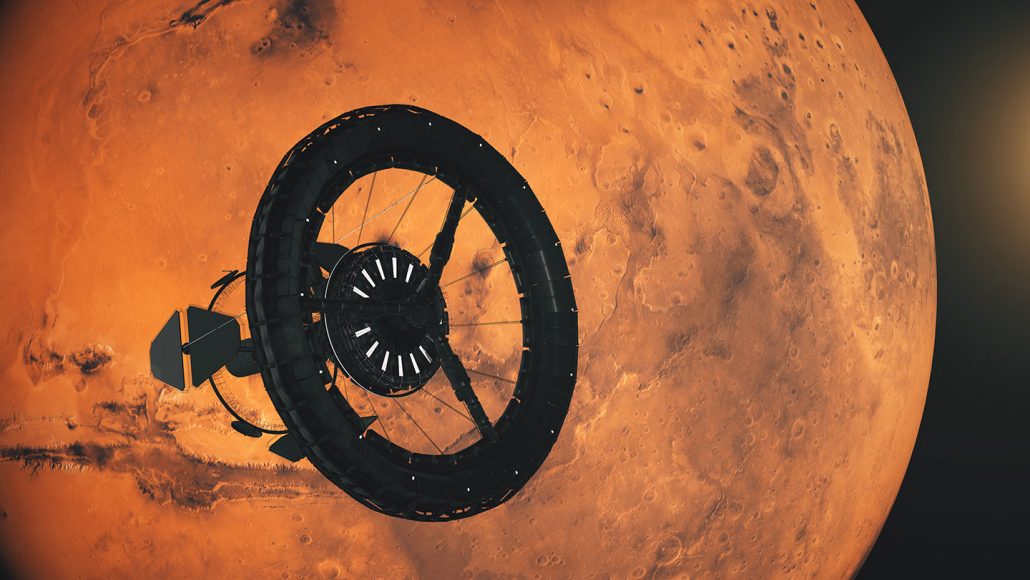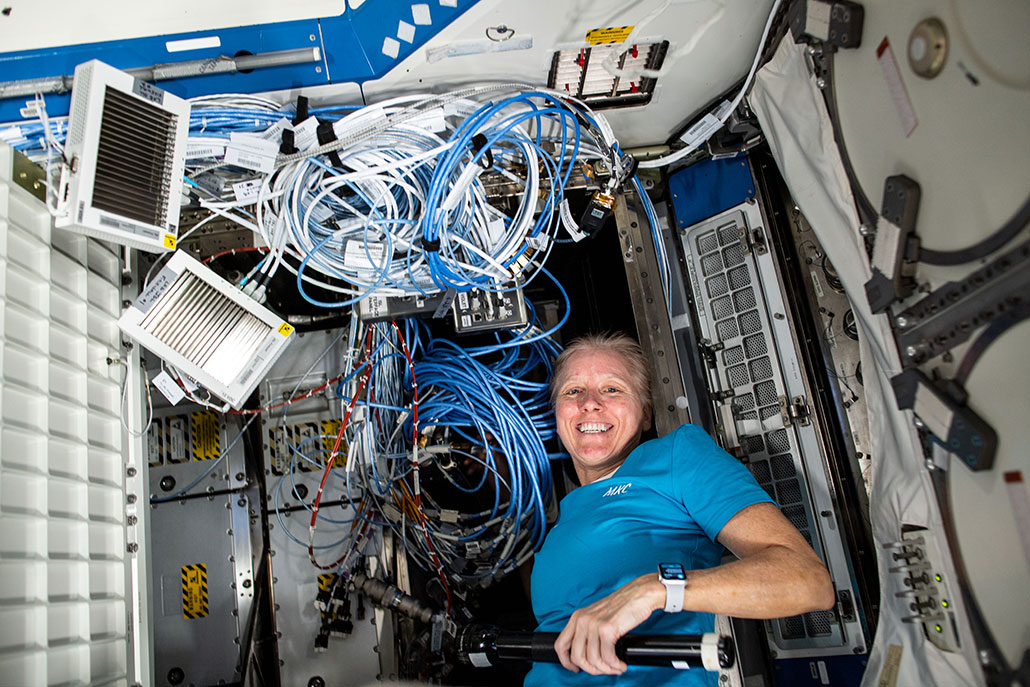Staying grounded in space requires artificial gravity
There’s no gravity in space, but scientists have a few ideas on how to make it

This is an artist’s image of a space station orbiting Mars. The huge ring could rotate, bringing artificial gravity to the people inside.
cokada/iStock/Getty Images Plus
In lots of books, movies and TV shows, people on spaceships walk around like they would on Earth. In real life, though, astronauts in space float. The difference isn’t just because the books, movies and TV are fiction. It’s that in those fictional worlds, artificial gravity exists. In our world it doesn’t — yet. But it may be coming.
Gravity is a fundamental force. It attracts objects with mass toward each other. Objects with a lot of mass — such as Earth — attract other objects toward their centers. This is why we stand firmly on the ground no matter where on Earth we are. Gravity decreases with distance, though. So as people travel to the Moon or Mars, their pull toward Earth quickly weakens, which leaves them floating.
This might seem like fun. But life without gravity isn’t great. In the long term, our bones and muscles don’t work as hard in a gravity-free environment. This weakens them. Without gravity, blood and other bodily fluids don’t flow normally and can collect in the upper body. This can cut off hearing.
Also, floating around in zero gravity makes you puke.
In fact, notes Mika McKinnon, “We know a lot of ways to have the same effect as gravity using other forces.” She is a physicist with the Search for Extraterrestrial Intelligence (SETI) Institute. It’s in Mountain View, Calif. And at least a few of the simpler tactics might not be that far off.

Educators and Parents, Sign Up for The Cheat Sheet
Weekly updates to help you use Science News Explores in the learning environment
Thank you for signing up!
There was a problem signing you up.
Mass attraction
One approach would be to “use electricity and magnetism as a way of substituting for gravity,” McKinnon explains. “You can create that magnetic field by running electricity around in circles,” she says. The flow of electric current produces magnetism. All an astronaut would have to do is wear metal boots. The attraction between the metal and the magnet would help someone walk along the floor.
The work required to walk against a magnet might also limit bone and muscle loss in space. But being stuck to the floor isn’t the same as gravity. Fluids would still be able to collect in the upper body. And your stomach would still be awfully confused.
Scientists could try to harness real gravity, McKinnon says. Everything with mass has gravity, she points out. So one simple idea would be to have a lot of mass. “Build yourself a planet and then you’ve got enough gravity,” she notes. Then again, she adds, That’s not very convenient to have to build a planet or carry a planet around with you.” Instead, she explains, the key might be to get a lot of mass into a very small area.
Neutron stars, for example, are extremely dense. A teaspoon of neutron-star material might be enough to give us gravity, she says. Or a “tiny pencil prick” of a black hole. Both of these exert vast amounts of gravity for their size.
But how could you contain a black hole — even a tiny one — in the middle of a spaceship? “That’s an engineering problem,” McKinnon says. “And we have no idea what the engineering would be.”
Ring around the spaceship
If you’ve ever been on a carnival ride like the spinning teacups, you’ve felt artificial gravity. When you are inside a large, spinning object, you will feel a pull toward the outside wall. This is because of inertia. Your body is resisting the change in motion of the object spinning around you.
We feel inertia as something that doesn’t exist — centrifugal force. This force seems to pull us to the outside edge of the rotating teacup.
Centrifugal force is really inertia. But if all you need is artificial gravity, then such an imaginary force works fine. All you need is either a small ship, rotating very fast, or a very large ship rotating slowly. Either way, the spin would pull someone feet-first toward the outside wall.
This is an improvement over magnets, because the whole body would feel the effect. Blood and fluids would move through the body just as they do on Earth. Bones and muscles would feel the pull when someone walked or ran.
A large version of such a system is called an O’Neill cylinder. It’s named for physicist Gerard O’Neill, who came up with the idea. A pair of these vast rotating cylinders would sit aimed toward the sun and spin in opposite directions. Those opposite spins would help hold them in place.
“The only reason we won’t have them is they are huge,” explains Joalda Morancy, who uses they/them pronouns. A junior at the University of Chicago in Illinois, they are studying physics and astronomy. Morancy also is an intern at NASA’s Jet Propulsion Laboratory in Pasadena, Calif.
And Morancy isn’t kidding when they say O’Neill cylinders are huge. O’Neill’s original idea was to create space habitats eight kilometers (five miles) across and 32 km long. “About a million people could live there,” Morancy says. “I really wish I could get to see one.”
Jeff Bezos, the founder of Amazon and the space company Blue Origin, is interested in building O’Neill cylinders. But that’s a long way off.
There’s also the problem of where to build them. Such a structure could probably be built on Earth. But how do you send something 32-km long into space? “It would cost so much and take a lot of rockets,” Morancy says.
An easier, lower cost option would be to assemble those giant habitats in space. But “we’re closer to the tech to get us to Mars than we are to building things in space,” Morancy notes.

Spin your astronaut round and round
Smaller rotating objects can provide the same effect as O’Neill cylinders. The smaller the object is, though, the faster is must spin to give you the feeling of gravity. And that spin has its own challenges. Spend enough time in a small spinning teacup and your stomach may soon object.
What’s more, people in or on rotating objects suffer from the Coriolis effect. This is a deflection that occurs when objects not attached to the ground travel at high speeds or long distances relative to a rotating planet. As an object flew through the air, the ground below would be spinning. So the object would appear to deflect a little, landing to the side of where it was headed. Most of the time, this difference is so tiny you’d never notice. If you threw a baseball from New York City to the equator, though, you definitely would.
The Coriolis effect is another fake force. Like centrifugal force, it’s actually inertia (yes, again). And like centrifugal force, the Coriolis effect is noticeable. In a fast-spinning spaceship, your arms would be forced to one side as you lifted them.
But the effect on your arms is nothing compared to the effect on your brain. People in a quickly rotating cylinder suffer from what’s called the cross-coupled illusion, notes Katherine Bretl. She’s an aerospace engineer at the University of Colorado in Boulder. When someone is inside a spinning ride — or a spinning space station — they often feel fine as they look forward. The cross-coupled illusion is that “tumbling feeling you get when you turn your head.”
Luckily, Bretl has found a way to overcome the problem. She and her colleagues have been putting people in a spinning chair and making them turn their heads for science. In one study, each recruit sat in the spinning chair for 25 minutes each day for 10 days. The chair started out spinning slowly — only once per minute. Over time, Bretl slowly increased the speed. After some 10 days, volunteers could tolerate being spun around more than 11 times per minute. After 50 days of training, they can spin more than 25 times per minute, on average. And to date, Bretl adds, “We haven’t had anyone puke.”
In 2019, her team described the 10-day procedure in the Journal of Vestibular Research. The 50-day results appeared last year in the journal npj Microgravity.
A room on the space station could rotate fast enough that astronauts would feel a gravitational force of about 1 g — the same as they would feel on Earth. The room wouldn’t have to be big, only about 2.6 meters (8.5 feet) across. That’s small enough to attach to the ISS. “Maybe a pair of modules opposite of one another rotate,” Bretly says. “Astronauts would be standing on a treadmill as this system is rotating.” The astronauts could work out in the rotating gyms, to make sure their muscles, bones and circulation stayed healthy. The rest of the time they would float throughout other parts of the space station.
“I think a lot of people look at [artificial gravity] and think it’s super far off,” Bretl says. “But I don’t think it has to be.” Those huge O’Neill cylinders are probably a long way away. But “artificial gravity doesn’t require that large, super-expensive, massive system in order to provide benefits for the astronauts.”







